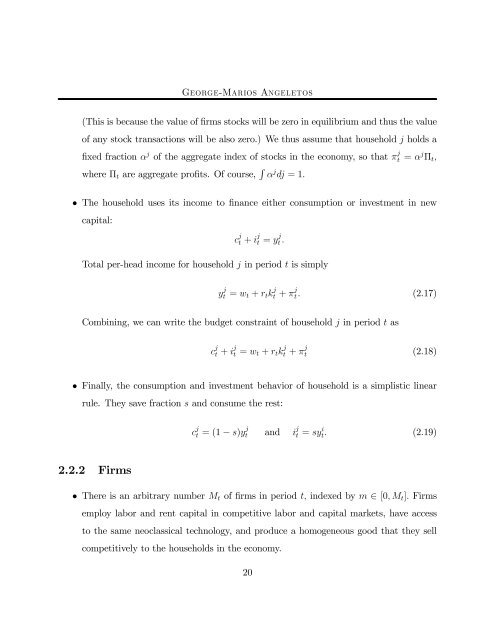14.451 Lecture Notes Economic Growth
14.451 Lecture Notes Economic Growth
14.451 Lecture Notes Economic Growth
Create successful ePaper yourself
Turn your PDF publications into a flip-book with our unique Google optimized e-Paper software.
George-Marios Angeletos<br />
(Thisisbecausethevalueoffirms stocks will be zero in equilibrium and thus the value<br />
of any stock transactions will be also zero.) We thus assume that household j holds a<br />
fixed fraction α j of the aggregate index of stocks in the economy, so that π j<br />
t = α j Πt,<br />
where Πt are aggregate profits. Of course, R α j dj =1.<br />
• The household uses its income to finance either consumption or investment in new<br />
capital:<br />
c j<br />
t + i j<br />
t = y j<br />
t .<br />
Total per-head income for household j in period t is simply<br />
y j<br />
t = wt + rtk j<br />
t + π j<br />
t. (2.17)<br />
Combining, we can write the budget constraint of household j in period t as<br />
c j<br />
t + i j<br />
t = wt + rtk j<br />
t + π j<br />
t<br />
(2.18)<br />
• Finally, the consumption and investment behavior of household is a simplistic linear<br />
rule. They save fraction s and consume the rest:<br />
2.2.2 Firms<br />
c j<br />
t =(1−s)y j<br />
t and i j<br />
t = sy i t . (2.19)<br />
• There is an arbitrary number Mt of firms in period t, indexed by m ∈ [0,Mt]. Firms<br />
employ labor and rent capital in competitive labor and capital markets, have access<br />
to the same neoclassical technology, and produce a homogeneous good that they sell<br />
competitively to the households in the economy.<br />
20

















